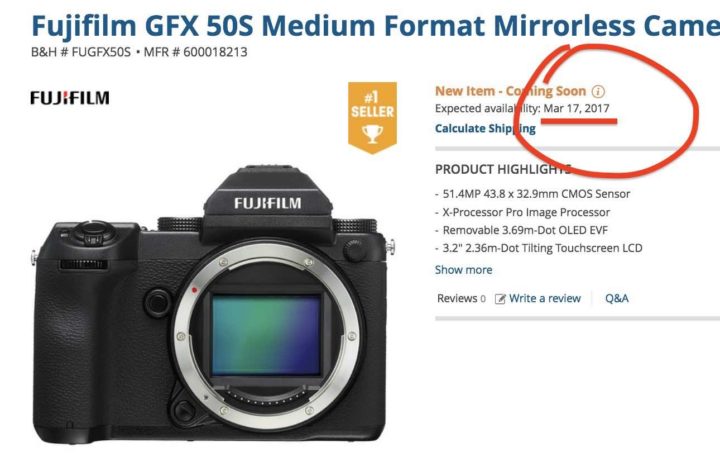
shared by Michael at the GFX facebook gourp here. Michael Schnabl photography: Photo: Michael Schnabl. Model: Alena Tsar shot with Fuji GFX and GF 120mm
Fujinon GF120mmF4 Macro: USA: BHphoto, Adorama, AmazonUS
Fujifilm GFX
The Fujifilm GFX facebook group has just reached the 9,000 members, and as you can imagine, the buzz over there is an incredible joy to follow.
And of course the feedback about the GFX is massive. It’s a closed group, so only members can see the content. But I can share a a few tidbits here on FujiRumors for you.
Let’s start with Marven, who shared his experience at the group here (visible only to members, but full story and images below) after shooting with the Fujifilm GFX + 32-64 handheld with the wrong settings (medium size JPEG only):
“My first impressions of the Fujifilm GFX 50S? Holly sh*t!!!
Even if you are used to looking at detailed images from a high-end DSLR like my Canon 5DSR (which is an excellent camera in it’s own right), the GFX images will blow you away! It has enough detail and resolution for even the most discerning pixel peepers.
I wasn’t going to upload any of these images because I hadn’t really set-up the camera yet and in fact discovered later that ALL of the settings were not to my liking straight out of the case. On my way home with the camera I passed by this gorgeous field of flowers and just hopped out and started taking pictures without thinking much about the camera’s default factory settings. In this case, the files were medium rez JPEGs in the sRGB colorspace. If I had checked my settings properly, I probably would have opted to shoot RAW or at the very least SuperFine (Fujifilm’s highest resolution for JPEG images) in AdobeRGB colorspace. I might have even chosen the Velvia Film Simulation for these high contrast, vivid shots.
Which is why these images impress me so much; the camera wasn’t even set up to deliver it’s best performance and yet when I cropped in on the Bee in the frame, the details simply blew me away. You can clearly see the pollen accumulated on his underbelly as well as the fine detail in his wings. And one must keep in mind that it wasn’t like he was a willing subject, he was buzzing around from flower to flower with me chasing him trying to snap a shot.
Which brings me to my final point. THE IS A MEDIUM FORMAT CAMERA FOR CRIS SAKE! Yet is feels so light and so nimble that I actually felt compelled to spontaneously jump out and shoot with it as though it were a point-and-shoot. Anyone who has shot MF knows the size and weight restrictions that accompany something like a Phase One XF system. It’s simply a massive camera with massive lenses and there is just no way I would want to lung it around for anything other than the most critical jobs. But the GFX is so lightweight, it makes shooting with a MF camera (dare I say) fun!!! I can tell I’m really going to love shooting with this camera.”
Fujifilm GFX: USA BHphoto, Adorama, AmazonUS
Fujinon GF32-64mmF4: USA: BHphoto, Adorama, AmazonUS
Fujifilm GFX + GF32-64mm + Handheld + medium size JPEG /sRGB

Crop of medium size JPEG /sRGB

_ _ _
GFX member Sung owns both, the Fujifilm GFX and the Sony A7rII, and he decided to compare both cameras’ shadow recovery capability. As usual, you can read it at the group here if you are a member and eventually interact with Sung.
“Dynamic range comparison between GFX 50s and A7rII. GF 63mm at f2.8 on GFX and ZY Optics 50mm at f2.0 on a7rii. Each combination shot at ISO 100 with shutter speed adjusted to be 5 full stops below auto exposure level. Each imported straight into Lightroom at base setting with no sharpening or noise reduction. Exposure pushed 5 stops and shadows slider maxed out at 100. The GFX 50s looks to me about half a stop ahead of the a7rii. Color fidelity is also better on the GFX 50s. First 100% crops, then 4×3 jpegs are attached.”
Fujifilm GFX 100% crop of a 5 stops underexposed image and then +5 on exposure slider and +100% on shadow slider

Sony A7rII 100% crop of a 5 stops underexposed image and then +5 on exposure slider and +100% on shadow slider

_ _ _
Another Dynamic Range test shared by GFX facebook member Hải S. here


_ _ _
and for Bokeh lovers, shared by Gary here: Couple for the ‘Bokeh’ fans. Fuji GFX, 63mm, Hong Kong. All shot candidly in Central early evening today.
Fujinon GF63mmF2.8: USA: BHphoto, Adorama, AmazonUS
































